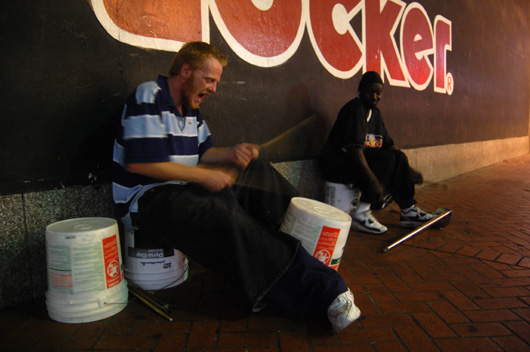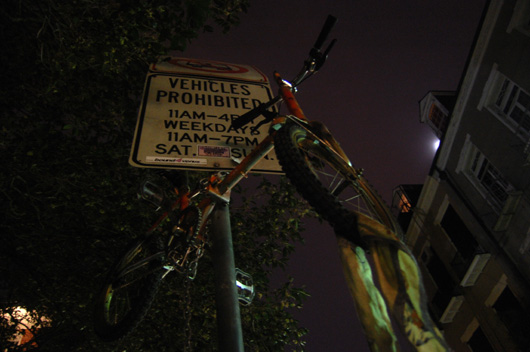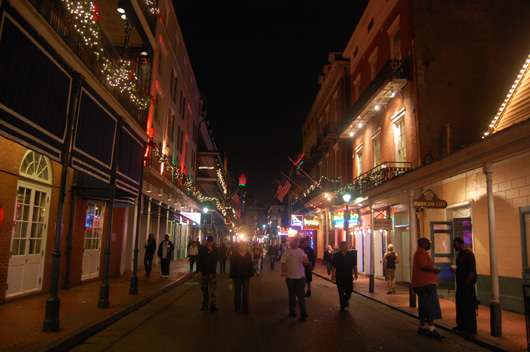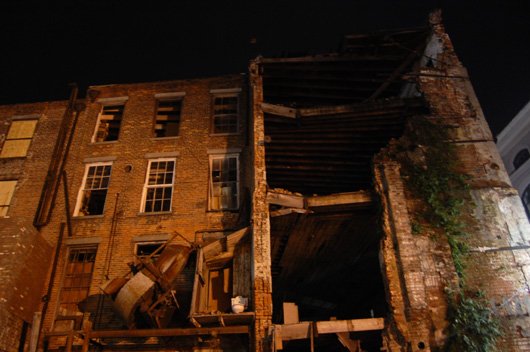
They call themselves "Salt and Pepper," but they don't do much shaking, just beating. The bucket drum duo says, "We're just glad to be back in New Orleans." There's a five-gallon bucket between the men: That's for spare change. As for the beer cans, also hidden from view in this shot, well, they're not empty. A group of drunken men, fresh from one of the many Bourbon Street bars, would soon join them, thinking they could also make music with such basic instruments.

A bicycle was chained to a "VEHICLES PROHIBITED" sign just off Bourbon Street. Is this someone's attempt at irony?
The conversation between the two college-age women was about boys. When the boys joined in, it quickly turned to beer, wine and hard liquor.
Those seem like popular topics in the Big Easy.
I sat nearby in the hostel's lobby as the two women commiserating with each other about men became a dozen young college students stressing about what they wanted to do on a Wednesday night. I had to eavesdrop. My ears were burning.
They talked about taking the "L" train to classes - calculus, mainly - and about "the lake," so I gathered that they were from Chicago.
One wanted to go to Bourbon Street, the appropriately named, mostly walkable thoroughfare through the historic French Quarter, about a 15-minute walk from the hostel. But one said, "The front-desk lady said, 'Babe, Bourbon Street ain't poppin' tonight.'" It WAS Wednesday after all. (The front-desk lady calls everyone babe.)
Another wanted to go to Wal-Mart and pick up some beer. "Ten bucks each should be enough," one young man said, figuring how much money it would take for everyone to get drunk. Others thought the idea was "lame."
They couldn't decide what to do, so they compromised: They would go to Bourbon Street, check it out, and if it wasn't "poppin,'" Wally World would be a good plan B. A few were underage, I heard them say, but they would try it anyway. The Bourbon Street supporters were talking about getting hurricanes, drinks that I heard stories about during the storm: People were pounding them down while the deluge raged outside the walls of their homes. Katrina was just one big party for them. Until the deluge broke down those walls.
Another drink was the hand grenade. I had never heard of it. So I went to Bourbon Street to find out. And boy, it was hard to miss.

Looking toward the business district from the middle of Bourbon Street, party central.
It was about 10:30 p.m. Hundreds of people were walking up and down Bourbon, above, with green plastic "hand grenades" filled with what the signs for the bar Tropical Isle (on the corner of Bourbon and Toulouse streets) bill as "New Orleans' strongest drink." The plastic cup looks like a bong more than a grenade - and not the kind you drink from, but the kind you suck smoke from.
Bourbon is one constant party. Strip clubs. Pornography stores. Honky tonk hoedowns. Oyster bars. Cheesy souvenir shops. Always plenty of alcohol. Some business names are original: La Bayou, Bourbon Cowboy, Gumbo Ya Ya. Some are not: The Frat House, Temptations, Meow. The city allows people to drink in the streets as long as their containers aren't glass. Some bars never close, so there is plenty of supply. And as long as New Orleans is a party town, there will be plenty of demand. Some Bourbon-goers are locals trying to drown away the floods that did a pretty good job of ruining their lives. Even the attendants at a parking garage off Bourbon Street sipped beer from clear plastic cups.
I felt somewhat uneasy as I walked down Bourbon, especially with the strap of an expensive camera strung around my neck. I'm not that "into" the party scene, and Bourbon isn't exactly the center of morality. It's part of the reason some made the argument that New Orleans was wrecked: Its blatant lack of morals brought the wrath of God, they said. I think it says in the Bible somewhere that God is done using floods to cleanse filth from the human race. Katrina was nothing short of tragic.
The French Quarter is obviously a source of pride among New Orleanians. Along with the ubiquitous glitz of casinos, it's a huge tourist draw. But for the amount of partying that happens on Bourbon, the street is relatively devoid of litter, except for the occasional string of beads, which are a year-round thing, not just for Mardi Gras in February. I didn't spot a single pile of vomit. That was a plus.
But if you were to walk a few blocks in any direction, you would realize that the city has focused most of its efforts on the big-draw neighborhoods, while others have suffered.

A wall is missing from a building in the business district.
In the business district, a four-story building is without its north face, above. Many buildings are hollowed out and boarded up.
The Ernest N. Morial Convention Center stretches along the Mississippi River, of which I caught my first glance today. After the Superdome, it was the next safe house where many survivors were taken after Katrina, and today, it's as shiny as ever. But a few blocks away, grass has overtaken the sidewalks. A backhoe sits atop a mound of bricks. A dump truck, its windows rolled down, sits abandoned along the street.

A horrible shot, but still, it shows two trailers (one in the front yard jutting onto sidewalk, one in the driveway) by a small home apparently too damaged to be livable.
As I walked through the desolate, dark streets of the Warehouse and Garden districts, sometimes fearing for my safety when a car sped by, I came upon a tiny, one-story house. It was dark, so I couldn't guage its condition. A white Cavalier trailer marked with a series of numbers and letters choked the front yard, blocking a good view of the house. The yard was so small that the trailer jutted into the sidewalk, above. In the house's driveway, there was a second trailer. I paused. I snapped some photos. Then I heard a man and a woman arguing inside the trailer.
To see a city so full of culture, so full of life in certain sections, then to witness the decrepit piles of wood, concrete and bricks that someone used to call home and to see the metal things on wheels that they now call home, it's disheartening. But I only have seen a few parts of the city where destruction was relatively minimal, and I saw them after sunset. Tomorrow, as I discover some of the other neighborhoods, the sun will rise. And I don't expect to like what I will see.
Assignment NOLA home page



No comments:
Post a Comment